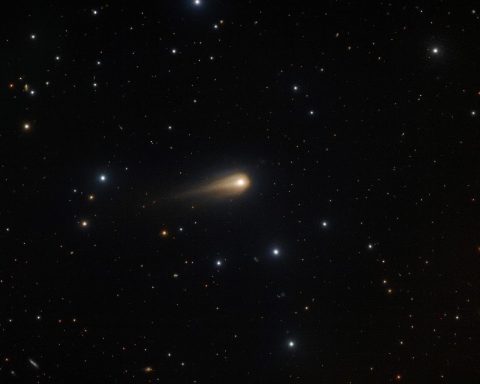- SpaceX operates over 7,000 satellites and posted $4.2 billion in revenue for 2024, with a target valuation of $400 billion to $4 trillion in upcoming funding rounds.
- Starlink aims for 22,000 satellites by 2030 and could capture 15% of global communications spending.
- Ovzon secured a SEK 72 million order from Sweden’s FMV for mobile satellite terminals, with deliveries starting in Q3 2025.
- MEASAT received IN-SPACe approval to provide satellite services in India, expanding access to over 600 TV channels and 11 million DTH customers.
- EarthDaily Analytics launched the first of its ten-satellite EarthDaily Constellation, delivering daily AI-ready, scientifically calibrated global imagery.
- NASA’s ATLAS telescope detected interstellar comet 3I/ATLAS, about 420 million miles from Earth, with closest Sun approach in late October and visibility through September before its December return.
- ESA’s Biomass satellite uses advanced radar to weigh forests from space, with long-wavelength radar penetrating canopies to measure biomass.
- Proba-3 mission uses two satellites in precise formation to create artificial solar eclipses for extended, high-resolution observations of the Sun.
- Axiom Space’s AxEMU spacesuit underwent its first crew test at NASA’s Neutral Buoyancy Lab, advancing preparations for Artemis III’s lunar south pole mission.
- The U.S. Air Force is evaluating environmental impacts of up to 76 SpaceX Starship-Super Heavy launches per year from Cape Canaveral, with hearings ongoing and initial findings indicating few significant impacts.
Space News Roundup: July 2025
The New Space Race: Commercialization, Constellations, and Billion-Dollar Markets
The 21st-century space race is no longer a duel between superpowers—it’s a global, multi-actor sprint, with commercial giants, startups, and governments vying for dominance beyond Earth’s atmosphere. Over 75% of the sector is now commercial, with satellite internet, direct-to-smartphone connectivity, and Earth observation fueling rapid growth and stable cashflows. SpaceX, for example, operates over 7,000 satellites and expects $4.2 billion in revenue for 2024, while aiming for a $400 billion to $4 trillion valuation in upcoming funding rounds ( [1], [2], [3]).Key Commercial Developments
- SpaceX’s Starlink: With ambitions for 22,000 satellites by 2030, Starlink is democratizing broadband access and could capture 15% of global communications spending ( [4]).
- EarthDaily Analytics: Launched the first of a ten-satellite constellation, promising daily, AI-ready, scientifically calibrated global imagery for industries and governments ( [5]).
- Ovzon: Secured a SEK 72 million order from Sweden’s FMV for mobile satellite terminals, reinforcing the importance of robust, mission-critical communications ( [6], [7]).
- MEASAT: Received IN-SPACe approval to provide satellite services in India, expanding access to over 600 TV channels and 11 million DTH customers ( [8]).
- Gilmour Space and Space BD: Partnership enables satellite launches from Australia, expanding launch options in the Asia-Pacific ( [9]).
- SoFi Technologies: Launches private-market funds for retail investors to gain exposure to SpaceX and other space startups ( [10]).
Outlook
The commercial space sector is poised for exponential growth, with new business models, increased investor access, and technological innovation driving down costs and expanding market reach. However, risks remain, including regulatory hurdles, competition, and the need for robust collision avoidance and space traffic management systems.Satellite Technology: Innovation, Security, and Societal Impact
Next-Gen Satellite Constellations
- Russia is planning its largest satellite constellation ever, with over 300 spacecraft for communications, Earth observation, and navigation ( [11]).
- China is accelerating space computing by integrating AI processing units into satellite constellations, aiming for real-time data processing in orbit ( [12]).
- TANGO (Netherlands): Launching in 2028, this system will map global greenhouse gas emissions at the source, supporting climate policy ( [13]).
- EarthDaily Analytics: As above, their constellation promises daily, high-precision Earth observation.
Security and Quantum Advances
- India: Space TS and Synergy Quantum are developing the country’s first quantum-secure satellite, aiming for post-quantum resilient space infrastructure ( [14]).
- Morocco: Acquiring SAR-equipped satellites for 24/7 border monitoring, shifting to a proactive security strategy ( [15]).
- Ukraine: The ICEYE satellite, purchased via public donations, has outlived its warranty and continues to provide vital military intelligence ( [16]).
AI and Advanced Design
- Proteus Space: Built a satellite in just 8 months using AI-driven design, with onboard self-diagnosis and rapid configuration analysis ( [17]).
- Neuraspace: Developing AI-powered software for satellite collision avoidance, supported by ESA ( [18]).
- Valencia’s Estigia CubeSat: Aims to connect with schools from space, acting as a “mini ChatGPT in orbit” ( [19]).
Market Trends
- The Satellite Optical Components Market is projected to reach $3.17 billion by 2032, driven by demand for high-resolution imaging, laser communication, and miniaturized satellites ( [20]).
- ETF Performance: Satellite-related ETFs have seen mixed performance, reflecting both the promise and volatility of the sector ( [21], [22]).
Outlook
Satellite technology is rapidly evolving, with AI, quantum encryption, and real-time data processing at the forefront. As constellations proliferate, the need for robust collision avoidance, cybersecurity, and international cooperation will only intensify.Space Science: New Discoveries, Missions, and Astrophotography
Interstellar Visitors and Solar System Science
- 3I/ATLAS: NASA’s ATLAS telescope discovered the third known interstellar comet, offering a rare chance to study material from another star system ( [23], [24], [25]).
- Vera C. Rubin Observatory: Released its first images, revealing thousands of new asteroids and promising a revolution in Solar System science ( [26]).
- ESA’s Biomass Satellite: Uses advanced radar to “weigh” forests from space, providing unprecedented data on global forest health and carbon storage ( [27]).
- Proba-3 Mission: ESA’s twin satellites create artificial solar eclipses for extended, high-resolution sun observation ( [28]).
Astrophotography and Public Engagement
- Astronomy Photographer of the Year 2025: The Royal Observatory Greenwich announced its shortlist, featuring stunning images of the Milky Way, auroras, and solar phenomena. Winners will be announced in September ( [29], [30], [31]).
Missions and Technology Demonstrations
- NASA’s PExT: The Polylingual Experimental Terminal will allow spacecraft to roam between government and commercial satellite networks, enhancing mission flexibility ( [32]).
- Axiom Space’s AxEMU Spacesuit: Underwent its first crew test, advancing preparations for Artemis III’s lunar south pole mission ( [33]).
- NASA Wallops: Schedules suborbital rocket launch for July 2025, continuing its role in research and technology demonstration ( [34]).
Theoretical and Cosmological Advances
- Dark Dwarfs: Researchers propose a new class of brown dwarf stars containing dark matter, potentially unlocking the secrets of this elusive substance ( [35]).
- Big Crunch Hypothesis: New data suggests dark energy may be decreasing, raising the possibility of a “Big Crunch” end to the universe in 33.3 billion years ( [36]).
Outlook
Space science is in a golden era, with new telescopes, satellites, and missions delivering discoveries at an unprecedented pace. The public’s engagement—through astrophotography, citizen science, and educational programs—remains vital for sustaining support and inspiring the next generation.Earth Observation: Satellites in Disaster Response, Climate, and Security
Floods, Conflict, and Environmental Monitoring
- Texas Floods: Satellite imagery from Maxar Technologies and others revealed the devastation at Camp Mystic and along the Guadalupe River, with over 100 deaths ( [37], [38], [39], [40]).
- Brazil Floods: ISS astronauts captured images of severe flooding along the Uruguay and Ibicuí rivers, supporting scientific and public understanding ( [41]).
- Ukraine: Satellite and drone imagery now enable remote assessment of war-damaged housing, streamlining compensation for affected residents ( [42]).
- Iran Nuclear Sites: Satellite images show bomb damage at Fordow and Natanz, with craters suggesting severe, long-term disruption ( [43], [44]).
Climate and Greenhouse Gas Monitoring
- GOSAT-GW (Japan): Launched to monitor greenhouse gases and sea temperature, marking the end of the H-2A rocket era ( [45]).
- MethaneSat: Despite revealing alarming methane emissions, the satellite has been lost in space, dealing a blow to climate monitoring and New Zealand’s space ambitions ( [46], [47], [48]).
- ESA Biomass: As above, revolutionizes global forest health monitoring.
Precision Agriculture
- Krasnoyarsk Scientists: Using satellite and drone data for targeted fertilizer application, improving yields and reducing environmental impact ( [49]).
Outlook
Earth observation satellites are indispensable for disaster response, climate monitoring, and national security. Their data informs policy, enables rapid response, and supports sustainable development. However, satellite loss (e.g., MethaneSat) and geopolitical tensions highlight the fragility and strategic importance of these assets.Space Policy, Regulation, and Environmental Concerns
Environmental Impact and Public Input
- SpaceX Starship Launches: The U.S. Air Force is seeking public input on the environmental impacts of up to 76 Starship-Super Heavy launches per year from Cape Canaveral. Initial findings suggest few significant impacts, but hearings continue ( [50]).
- US Air Force Halts SpaceX Hypersonic Cargo Rocket Tests: Tests on Johnston Atoll were suspended due to risks to native seabirds, following environmental lawsuits ( [51]).
Space Traffic Management and Safety
- US Collision Alert System: Industry leaders warn that proposed budget cuts could compromise space safety and operational reliability ( [52]).
- Neuraspace AI Collision Avoidance: As above, ESA-funded project to improve space traffic management.
Spectrum and Radio Interference
- 5G, Wi-Fi, and Starlink: Radio interference from terrestrial and satellite networks is disrupting radio telescopes’ ability to track black holes, threatening geodetic measurements vital for navigation and climate monitoring ( [53]).
International Partnerships and National Programs
- Australia’s Kanyini Satellite: Demonstrates sovereign space capabilities and advanced payloads, despite recent technical faults ( [54]).
- Xichang, China: Prioritizes commercial space industry, aiming for 1,000 satellite launches annually by 2030 ( [55]).
- SES Astra and MBS: SES sells its broadcast and content management operations to MBS to focus on core satellite transmission services ( [56]).
Outlook
As launch rates and satellite numbers soar, environmental stewardship, spectrum management, and international cooperation are more critical than ever. The balance between commercial growth and planetary protection will define the next decade of space activity.Lunar Science, Astronomy, and Public Fascination
The Buck Moon and Lunar Phenomena
- July 2025’s Buck Moon: The seventh full moon of the year, occurring just after Earth’s aphelion and during a rare Major Lunar Standstill, will be the farthest and one of the lowest in the sky ( [57], [58], [59], [60], [61]).
- Myths Debunked: Scientific studies find no significant evidence linking the full moon to sleep, menstruation, or childbirth ( [62]).
Astronomy Photographer of the Year
- As above, the ZWO Astronomy Photographer of the Year shortlist showcases global passion and technical excellence in astrophotography.
Outlook
Lunar events and public engagement through photography and myth-busting continue to inspire and educate, reinforcing the Moon’s role as a proving ground for future deep-space missions.Space Accidents, Anomalies, and the Unexpected
Capsule and Satellite Losses
- Nyx Capsule Crash: The Exploration Company’s capsule, carrying human remains and cannabis for research, crashed into the Pacific after parachute failure. The mission was a “partial success” and a learning opportunity ( [63], [64], [65], [66]).
- MethaneSat: As above, lost after revealing alarming methane emissions.
Mysterious Signals and Zombie Satellites
- NASA’s Relay 2 Satellite: Emitted a powerful radio burst after 60 years of silence, possibly due to a micrometeoroid impact or electrostatic discharge. This event may offer new ways to monitor electrical discharges in satellites ( [67], [68]).
Criminal Use of Space Tech
- Unmanned Narco-Submarines: Criminals are deploying unmanned, satellite-controlled submarines for drug trafficking, with the Colombian Navy intercepting the first such vessel using Starlink ( [69], [70]).
Outlook
Space is an unpredictable environment. Failures, anomalies, and even criminal innovation are inevitable. Each incident provides lessons for future missions, underlining the need for resilience, redundancy, and robust risk management.Space Exploration: Mars, the Moon, and Beyond
Mars Sample Return
- Lockheed Martin: Proposes a $3 billion, radically simplified plan to rescue NASA’s Mars Sample Return mission, potentially halving costs and leveraging extensive Mars experience ( [71], [72]).
Artemis and Lunar Exploration
- NASA Artemis Missions: Secured significant funding in the latest U.S. budget bill, ensuring continued support for Artemis 4 and 5 ( [73]).
- Axiom Space’s AxEMU Spacesuit: As above, advances Artemis III preparations.
National Programs
- Türkiye’s Türksat 6A: Celebrates one year in orbit, with over 80% of components locally made, boosting national space capabilities ( [74]).
- ISTSat-1 (Portugal): Marks one year in orbit, testing new aircraft message decoders for air safety ( [75]).
Outlook
Despite budgetary and technical challenges, lunar and Martian exploration remain central to national and international space agendas. New funding, innovative partnerships, and technological advances are keeping humanity’s deep-space ambitions alive.Space Data, Education, and Democratization
Data Access and Training
- Skynopy and SpaceLocker: Partner to democratize access to space and orbital data, reducing costs and complexity for commercial missions ( [76]).
- NASA ARSET: Migrates remote sensing training to the Earthdata platform, streamlining access for global users ( [77]).
- Satellite Communication Webinar: Zhongxing Lianhua and ADI to host a webinar on advanced satellite communication design and testing ( [78]).
Public Engagement and Inspiration
- Space Shuttle Discovery: Senate provision could move Discovery to Houston, honoring the city’s role in human spaceflight ( [79]).
- Model Rocketry: Amazon Prime Day offers top discounts for enthusiasts, promoting STEM engagement ( [80]).
Outlook
Access to space data, educational resources, and public engagement initiatives are crucial for building a diverse, informed, and inspired space community.Earth’s Rotation: Shortest Days and Surprising Science
- July 9, 2025: Predicted to be the shortest day ever recorded, with Earth’s rotation accelerated by 1.3–1.6 milliseconds due to the Moon’s position ( [81], [82], [83], [84]).
- Implications: Affects atomic clocks, GPS, and may require a negative leap second by 2029.
Recap: Key Takeaways
- Commercialization is driving unprecedented growth in the space sector, with SpaceX, EarthDaily, and others leading the way.
- Satellite technology is advancing rapidly, with AI, quantum security, and real-time data processing at the forefront.
- Earth observation satellites are vital for disaster response, climate monitoring, and security, but are vulnerable to loss and interference.
- Space science is in a golden era, with new discoveries, missions, and public engagement at record levels.
- Environmental and regulatory challenges are intensifying, requiring careful management and international cooperation.
- Lunar and Martian exploration remain central, with new funding and innovative approaches keeping humanity’s deep-space dreams alive.
- Education and data democratization are empowering a new generation of space enthusiasts and professionals.
- Earth’s rotation is delivering scientific surprises, with implications for timekeeping and navigation.
Looking Ahead
The next year promises further breakthroughs in satellite technology, commercial space ventures, and scientific discovery. As launch rates soar and new actors enter the fray, the need for robust regulation, environmental stewardship, and international collaboration will only grow. The democratization of space data and education will empower more people than ever to participate in humanity’s greatest adventure.Stay tuned for more in-depth analysis as the space sector continues its rapid transformation.For detailed source articles and further reading, please follow the embedded links throughout this report.
More today’s sources
Astronomy Photographer of the Year 2025 Shortlist Announced
The Royal Observatory Greenwich has revealed the shortlist for the 2025 ZWO Astronomy Photographer of the Year, featuring astrophotography of a blood Moon, auroras, and distant galaxies. Notable entries include images using data from NASA’s Solar Dynamics Observatory. Winners will be announced in September 2025.Continue reading on [85]
Space Race 2.0: The Billion-Dollar Market Beyond Earth’s Atmosphere
A new space race is underway, driven by commercial players like SpaceX and AST SpaceMobile. Over 75% of the sector is now commercial, with satellite internet (e.g., Starlink), direct-to-smartphone connectivity, and Earth observation fueling rapid growth and stable cashflows. SpaceX alone operates 7,000+ satellites and expects $4.2B revenue in 2024.Continue reading on [86]
Ovzon Secures SEK 72 Million FMV Order for Mobile Satellite Terminals
Ovzon received a SEK 72 million order from Sweden’s FMV for mobile satellite terminals compatible with high-performance SATCOM services and the Ovzon 3 On-Board Processor. CEO Per Norén stated, “This additional order confirms Ovzon’s important role in enabling robust and mission-critical communications in the most demanding environments.” Deliveries start Q3 2025.Continue reading on [87]
Ovzon Secures SEK 72 Million Order from FMV for Mobile Satellite Terminals
Ovzon received a SEK 72 million order from the Swedish Defence Materiel Administration for mobile satellite terminals compatible with Ovzon’s SATCOM services and Ovzon 3’s On-Board Processor. CEO Per Norén stated, “This additional order confirms Ovzon’s important role in enabling robust and mission-critical communications in the most demanding environments.”Continue reading on [88]
Japan Launches GOSAT-GW Satellite to Tackle Climate Crisis
Japan’s space agency JAXA launched the dual-purpose GOSAT-GW satellite on the H-2A rocket’s final mission. GOSAT-GW will monitor greenhouse gases and sea temperature to study climate change. The launch marks the end of the H-2A era, with the new H3 rocket set to take over future missions.Continue reading on [89]
Mysterious Radio Burst Detected from Defunct NASA Satellite Relay 2
Astronomers detected a powerful, mysterious radio burst in June 2024, traced to NASA’s inactive Relay 2 satellite, dormant since 1967. The ASKAP telescope recorded the brief 30-nanosecond signal. Experts suggest a static discharge or micrometeoroid impact as causes. “Such emissions may offer a new way to monitor electrical discharges in modern small satellites,” said physicist Karen Aplin.Continue reading on [90]
Air Force Seeks Public Input on SpaceX Starship Launches from Cape Canaveral
The U.S. Air Force is collecting public comments on the environmental impacts of up to 76 SpaceX Starship-Super Heavy launches per year from Cape Canaveral. Hearings are underway in Brevard County. A draft statement found few significant impacts. “The Air Force is committed to understanding and minimizing potential impacts on the diverse wildlife and habitats.”Continue reading on [91]
Satellite Imagery Reveals Bomb Damage at Iranian Nuclear Sites Fordow and Natanz
Satellite images analyzed by experts show US stealth bombers targeted Iran’s Fordow and Natanz nuclear sites with GBU-57 bunker-buster bombs. Craters near Fordow’s ventilation shaft suggest severe damage. David Albright noted, “You could put the facility out of commission for quite a long time, measured probably in a few years rather than a few months.”Continue reading on [92]
Nyx Capsule Crash: Human Remains and Cannabis Lost After SpaceX Rideshare Mission Failure
A Nyx capsule from The Exploration Company, carrying human remains and cannabis for research, crashed into the Pacific after its parachutes failed post-SpaceX launch. The company called it a “partial success” and a learning opportunity. CEO Hélène Huby said, “Partial success is often part of the road for those who take risks and push boundaries.”Continue reading on [93]
Maxar Satellite Images Reveal Flood Devastation at Texas Camp
New satellite imagery from Maxar Technologies highlights the severe damage at Camp Mystic, Texas, after deadly floods. The images show mud, debris, and destroyed structures, with previously green areas now devastated. More than 100 people died in Kerr County, including at least 27 at the camp, as confirmed by BBC Verify.Continue reading on [94]
Russia Suspends ‘Skif’ and ‘Marathon IoT’ Satellite Launches to Save Budget
Roscosmos has suspended the ‘Skif’ and ‘Marathon IoT’ satellite constellations to save federal funds. Director Dmitry Bakanov said private interest could revive support. The broader ‘Sfera’ satellite system remains active, integrating communications, Earth observation, and GLONASS navigation capabilities.Continue reading on [95]
How to See the 2025 Buck Moon: Date, Time, and Viewing Tips
The Buck Moon, the seventh full moon of 2025, will be the farthest full moon from the sun and one of the lowest in the sky. It will be visible on July 10 at 22:09 BST. NASA considers the Moon a “pivotal proving ground for future deep-space adventures.”Continue reading on [96]
Russia to Deploy Satellite Constellation of Over 300 Spacecraft
Russia plans to create a satellite constellation exceeding 300 spacecraft, marking its largest ever. Roscosmos chief Dmitry Bakanov stated, “One of the operators is deploying a constellation of more than 300 satellites.” The first serial launch is expected by the end of the year, showcasing Russia’s expanding satellite production capabilities.Continue reading on [97]
Why July 9 Will Be One of the Shortest Days on Earth in 2024
Earth’s rotation is speeding up, making July 9, 2024, one of the year’s shortest days by a few milliseconds. This phenomenon, measured by atomic clocks, results in days slightly shorter than 24 hours. Researcher Leonid Zotov notes the cause is unclear, but expects Earth’s rotation to regulate soon.Continue reading on [98]
Skynopy and SpaceLocker Partner to Democratize Space and Orbital Data Access
European startups Skynopy and SpaceLocker announced a strategic alliance to simplify and democratize access to space and orbital data. Their modular, shared-satellite and ground connectivity solutions aim to reduce costs and complexity for commercial space missions. SpaceLocker’s first satellite, ‘Out of the Box,’ will launch in 2026 with Skynopy providing ground segment services.Continue reading on [99]
SES Astra Sells Broadcast, Content Management, and IP Delivery Business to MBS
SES Astra has sold its broadcast, content management, and IP delivery operations in Germany and the UK to MBS, effective July 1, 2025. This move allows SES to focus on core satellite transmission services, while MBS expands its media solutions. SES aims to streamline operations and reinforce its satellite infrastructure offerings.Continue reading on [100]
Dutch TANGO Satellite System to Map Global Emissions with High Precision
Dutch experts are developing the innovative TANGO satellite system, launching in 2028, to measure global greenhouse gas and air pollution emissions at the source. TANGO will identify emissions from specific sites, aiding climate policy. KNMI’s Pepijn Veefkind states: “We make visible what is invisible, clarifying who emits what—essential for reducing emissions.”Continue reading on [101]
Portuguese University Nanosatellite ISTSat-1 Marks One Year in Orbit
The ISTSat-1, a nanosatellite built by IST students and professors, celebrates one year in space after launching aboard Ariane 6. It tests a new aircraft message decoder for remote detection and air safety. “Há uma infinidade de testes a fazer,” said engineer João Paulo Monteiro, highlighting ongoing mission activities and successful communication improvements.Continue reading on [102]
NASA Discovers Interstellar Comet 3I/ATLAS Passing Through Solar System
NASA’s ATLAS telescope has discovered an interstellar comet, named 3I/ATLAS, currently 420 million miles from Earth. The comet poses no threat and will reach its closest approach to the Sun in late October. Astronomers worldwide are studying its properties, with visibility expected until September before it reappears in December.Continue reading on [103]
Thunder Moon (Buck Moon) to Illuminate Night Sky This Week
The Thunder Moon—also called the Buck Moon—will be visible on July 10, marking the first full moon of astronomical summer. This event offers stargazers a chance to enjoy the illuminated moon, upcoming meteor showers, and views of the Milky Way throughout July.Continue reading on [104]
Satellite Communication Design and Testing Webinar by Zhongxing Lianhua and ADI
Zhongxing Lianhua and ADI will host a webinar on July 15, 2025, covering the full process of satellite communication design and testing. The event addresses system design, high-throughput satellites, and advanced testing solutions. ADI will share insights on maximizing payload throughput and power efficiency. High-performance ADI chips will be raffled during the event.Continue reading on [105]
Satellite Image May Reveal Amelia Earhart’s Lost Plane, Sparking New Expedition
A satellite image may show the wreckage of Amelia Earhart’s plane on Nikumaroro island, prompting a new search. Experts from Purdue University and archaeologists hope to confirm the find. Richard Pettigrew stated, “Îndeplinește toate criteriile. Totul se potrivește.” However, some remain skeptical, citing inconclusive evidence.Continue reading on [106]
Proteus Space Sets Record: Satellite Built in 8 Months with AI-Driven Design
Proteus Space claims a record by building a satellite in just 8 months, with launch set for October 2025. Veteran astronaut Steven Robinson called it “impossible,” but now leads the UCD payload team. Their AI-based system enables onboard self-diagnosis and rapid satellite design, analyzing 2,300 configurations in 10 minutes. “It’s like planning a house, but at space complexity,” Robinson said.Continue reading on [107]
Satellite Optical Components Market to Reach USD 3.17 Billion by 2032 Driven by Space Tech Demand
The Satellite Optical Components Market is set to grow from USD 1.83 billion in 2024 to USD 3.17 billion by 2032 (CAGR 7.1%), fueled by rising demand for satellite communication, high-resolution Earth observation, and advancements in laser communication and miniaturized satellites. Optical components are vital for imaging, data transmission, and remote sensing in space.Continue reading on [108]
NASA’s PExT Demonstration: Enabling Spacecraft to Roam Between Networks
NASA’s PExT (Polylingual Experimental Terminal) will demonstrate wideband terminals that allow spacecraft to seamlessly switch between government and commercial satellite networks, similar to cellphone roaming. This first-of-its-kind technology aims to support NASA’s transition to commercial space communications services by 2028, enhancing interoperability and mission flexibility.Continue reading on [109]
Morocco Enhances Intelligence with Advanced SAR Satellite Technology
Morocco is acquiring new SAR-equipped satellites, including Ofek 13, to enable 24/7 border monitoring in all weather conditions. Expert Hicham Moatadhed calls this a shift from “reactive policy to proactive security strategy.” These satellites will boost Morocco’s national security, strategic autonomy, and integration with Western systems.Continue reading on [110]
China Advances Key Metrology Technologies for Satellites and Spacecraft
China’s regulators announced a new plan to advance satellite remote sensing, on-orbit spacecraft operations, space exploration, and satellite communications metrology. The initiative targets breakthroughs in measurement and calibration for space stations, commercial satellites, and satellite internet, aiming to drive aerospace innovation and address technical challenges in the sector.Continue reading on [111]
ESA’s Biomass Satellite Revolutionizes Global Forest Health Monitoring
The new ESA Biomass satellite uses advanced radar to “weigh” forests from space, providing unprecedented data on global forest health and carbon storage. Its long-wavelength radar penetrates tree canopies for accurate biomass measurement. “The first images are simply spectacular,” says ESA’s Michael Fehringer, highlighting the mission’s potential for climate research.Continue reading on [112]
SpaceX Targets $4 Trillion Valuation in New Funding Round
SpaceX is seeking a record $4 trillion valuation through a new funding round and internal share sales. The move supports its ambitious space projects, including reusable rockets and the Starlink satellite internet constellation, reinforcing SpaceX’s leadership in the private space industry and highlighting the growing importance of space technology investments.Continue reading on [113]
Axiom Space’s AxEMU Spacesuit Undergoes First Crew Test at NASA’s Neutral Buoyancy Lab
Axiom Space’s next-gen AxEMU spacesuit was crew-tested for the first time in NASA’s Neutral Buoyancy Lab, advancing preparations for Artemis III’s lunar south pole mission. Key systems like communications, breathing, and cooling were evaluated, with further integrated testing ongoing to ensure astronaut safety, mobility, and mission readiness.Continue reading on [114]
How 5G, Wi-Fi, and Satellite Internet Threaten Black Hole-Based Navigation
Radio interference from 5G, Wi-Fi, and satellite internet, including Starlink, disrupts radio telescopes tracking black holes for geodetic measurements vital to satellite navigation. Dr. Lucia McCallum explains that “strong mobile signals drown out weak black hole signals,” risking navigation, communications, and climate monitoring. International cooperation and spectrum protection are needed to safeguard these measurements.Continue reading on [115]
Texas Floods: Before-and-After Satellite Images Reveal Devastation
Satellite images released on July 8 show the severe impact of flooding in central Texas and along the Guadalupe River, with significant destruction to trees and buildings. The disaster led to Kerr County being declared a ‘major disaster area’ to access federal relief funds. Satellite data highlights the scale of the catastrophe.Continue reading on [116]
Vera C. Rubin Observatory Releases First Images, Monmouth Professor Involved
The Vera C. Rubin Observatory’s 8.4-meter telescope released its first images, revealing thousands of new asteroids. Monmouth College’s Mike Solontoi, a long-time team member, called the telescope “a discovery engine” that will vastly expand our knowledge of the Solar System. “The first image asteroid data from Rubin discovered around 2,100 new asteroids,” said Solontoi.Continue reading on [117]
Swedish FMV Places Additional Order for Ovzon Mobile Satellite Terminals
The Swedish Defence Materiel Administration (FMV) has ordered more Ovzon mobile satellite terminals, valued at SEK 72 million, for use with high-performance SATCOM services. Ovzon T7 and P30 terminals support robust, mission-critical communications, enhancing Sweden’s operational autonomy. CEO Per Norén stated, “We continue to see strong demand for our SATCOM solutions.”Continue reading on [118]
Samsung W26 Foldable Phone Passes 3C Certification with Satellite Communication Support
Samsung’s upcoming W26 foldable phone has passed China’s 3C certification, confirming satellite communication support and up to 25W charging. Targeted at business users, the W26 continues the ‘Heart to the World’ series. No further specifications were revealed in the certification details.Continue reading on [119]
Krasnoyarsk Scientists Boost Agriculture with Satellites and Drones
Krasnoyarsk scientists developed precision agriculture methods using satellite and drone data to optimize fertilizer use, increase yields, and reduce environmental impact. “Such approaches provide economic and environmental benefits from the first year,” said Anatoly Shevyrnogov, chief researcher at the Institute of Biophysics SB RAS. The technology may form the basis for a regional science-industrial campus.Continue reading on [120]
Krasnoyarsk Scientists Boost Agriculture with Satellites and Drones
Krasnoyarsk scientists developed precision agriculture methods using satellite and drone data for targeted fertilizer application, improving yields and reducing environmental impact. “Such approaches provide economic and ecological returns from the first year,” said Anatoly Shevyrnogov, chief researcher at the Institute of Biophysics SB RAS. The technology may form the basis for a new science-industrial campus.Continue reading on [121]
EarthDaily Launches First Satellite in Advanced Earth Observation Constellation
EarthDaily Analytics has launched the first satellite of its ten-satellite EarthDaily Constellation, achieving initial contact and stable operation. CEO Don Osborne stated, “This is not just the start of a constellation, it’s the beginning of a new era in Earth observation.” The system will deliver daily, AI-ready, scientifically calibrated global imagery for industries and governments.Continue reading on [122]
EarthDaily Launches First Satellite in Advanced Earth Observation Constellation
EarthDaily Analytics has launched the first satellite of its ten-satellite Earth observation constellation, achieving initial contact and power-positive orientation. The system will deliver daily, AI-ready global imagery for precise change detection. CEO Don Osborne stated, “This is not just the start of a constellation, it’s the beginning of a new era in Earth observation.”Continue reading on [123]
Fifth-Generation Narco-Submarines: Unmanned and Satellite-Controlled
Criminals are deploying unmanned narco-submarines equipped with satellite internet (e.g., Starlink) for remote operation. This marks a leap in sophistication, creating subaquatic narco-drones immune to human vulnerabilities. The Colombian Navy recently captured such a vessel, highlighting the integration of aerospace technology in illicit trafficking.Continue reading on [124]
US Air Force Halts SpaceX Hypersonic Cargo Rocket Tests Over Seabird Concerns
The US Air Force has suspended plans to test SpaceX hypersonic cargo rockets on Johnston Atoll, citing risks to native seabirds. The decision follows a lawsuit by the Center for Biological Diversity and highlights ongoing criticism of SpaceX’s environmental practices, including previous wildlife impacts at launch sites.Continue reading on [125]
Türkiye’s Türksat 6A Celebrates First Year in Orbit, Boosts National Space Industry
Türksat 6A, Türkiye’s first domestically developed communications satellite, marks one year in orbit, enhancing national space capabilities. Over 80% of its components are locally made. Minister Uraloğlu stated, “The Türksat 6A project will offer Türkiye new opportunities in many areas, such as communications, the defense industry, scientific discoveries, and global data infrastructure.”Continue reading on [126]
Valencia’s First AI-Enabled Satellite Aims to Connect with Schools from Space
A student team at Universitat Politècnica de València is building Estigia, the region’s first AI-powered CubeSat. Estigia will enable real-time interaction with students and the public, acting “like a mini ChatGPT in orbit,” says team spokesperson Guillermo Jarque. The mission highlights local innovation and aims for launch in 2025 or 2026.Continue reading on [127]
MethaneSat Lost in Space: Alarming Methane Emissions Revealed
The MethaneSat satellite, launched by EDF with support from Amazon and Google, is lost in space after revealing that methane emissions are far higher than previously estimated. “The satellite ‘is likely unrecoverable,'” its creators stated. Methane’s global warming potential is 84 times that of CO2, raising serious climate concerns.Continue reading on [128]
Xichang Prioritizes Commercial Space Industry as Top Project
Xichang has designated commercial space as its top future industry, leveraging proximity to the Xichang Satellite Launch Center and rich mineral resources. Projects like the Shenzhen Mofang satellite factory (70% complete) and new satellite and rocket initiatives are accelerating. By 2030, Xichang aims for an annual launch capacity of 1,000 satellites and a robust space industry cluster.Continue reading on [129]
Senate Passes Provision to Move Space Shuttle Discovery to Houston
Senator John Cornyn’s provision to reconsider relocating the Space Shuttle Discovery from Virginia to Houston’s NASA Johnson Space Center passed in the Senate. The legislation aims to honor Houston’s pivotal role in human spaceflight and could inspire future generations. “Houston has long been the cornerstone of our nation’s human space exploration program,” said Sen. Cornyn.Continue reading on [130]
MethaneSat Lost in Space: Major Setback for Climate Monitoring
MethaneSat, a satellite backed by Jeff Bezos and Google, has been lost in space after revealing that methane emissions are much higher than previously thought—up to ten times more in some regions. This loss is a major blow to climate monitoring and efforts to combat greenhouse gases.Continue reading on [131]
NASA Wallops Schedules Suborbital Rocket Launch for July 2025
NASA’s Wallops Flight Facility in Virginia will support a suborbital rocket launch between July 9-19, 2025. No real-time launch status or livestream will be provided. This mission highlights Wallops’ ongoing role in launch operations for suborbital research.Continue reading on [132]
Satellite ETF (159206) Drops 0.69% with Midday Turnover of 5.65 Million Yuan
Satellite ETF (159206) fell 0.69% at midday, with a turnover of 5.65 million yuan. Major holdings include China Telecom and China Satellite. The ETF tracks the commercial satellite communications industry index. Investors are advised to exercise caution due to market risks.Continue reading on [133]
Satellite Industry ETF (159218) Drops 0.56% with Key Satellite Stocks Mixed
The Satellite Industry ETF (159218) fell 0.56% by midday, with a turnover of 3.81 million yuan. Major holdings include China Satellite, China Satcom, and Beidou Navigation-related stocks, showing mixed performance. The ETF tracks the CSI Satellite Industry Index and has returned 7.5% since inception. Market risks remain; investment caution is advised.Continue reading on [134]
Gilmour Space Partners with Space BD for Satellite Launches from Australia
Gilmour Space has teamed up with Japan’s Space BD to offer global satellite launch services from its Bowen Orbital Spaceport in Australia. The deal enables dedicated and rideshare missions on the Eris rocket and ElaraSat, expanding launch options in the Asia-Pacific. ‘This partnership opens new opportunities,’ said Gilmour Space’s David Jervis.Continue reading on [135]
Ukrainian ‘People’s Satellite’ ICEYE Surpasses Warranty Period, Continues Military Support
The Ukrainian ‘People’s Satellite’ ICEYE, purchased via public donations, has exceeded its 3-year warranty but remains fully operational for military intelligence. ICEYE satellites have provided 5,200 images, crucial for Ukraine’s defense. ICEYE’s representative confirmed the satellite ‘will continue to perform its tasks until its physical resource is exhausted.’Continue reading on [136]
ISS Astronauts Capture Flooding Along Uruguay and Ibicuí Rivers in Brazil
Astronauts aboard the International Space Station photographed severe flooding along Brazil’s Uruguay and Ibicuí rivers after torrential rains in June 2025. The ISS imagery, acquired with a Nikon Z9 camera, highlights the disaster’s extent and supports scientific and public understanding of flood impacts. The ISS National Lab facilitates such valuable Earth observation.Continue reading on [137]
3 Myths About the Full Moon: Sleep, Menstruation, and Births Debunked
This article debunks three common myths about Earth’s satellite, the Moon: its supposed influence on sleep, menstruation, and childbirth. Scientific studies, including those cited by the NIH, found no significant evidence linking lunar phases to these human phenomena. The belief in erratic behavior during the full moon is also a “lenda urbana.”Continue reading on [138]
NASA ARSET Training Program Moves to Earthdata Platform
NASA ARSET has migrated its remote sensing training content to the Earthdata platform, streamlining access to open-access satellite data and tools for global users. The program offers online and in-person courses on environmental management, air quality, disasters, and more, enhancing user experience by integrating training with data resources.Continue reading on [139]
Third Interstellar Object Detected in Solar System: 3I/ATLAS
Astronomers have identified 3I/ATLAS, only the third known interstellar object to enter our solar system. First spotted in Chile on July 1, its trajectory was confirmed by the International Astronomical Union’s Minor Planet Center. This rare discovery provides new opportunities to study objects from beyond our star system.Continue reading on [140]
When to See the Full Buck Moon on July 10, 2025: Times and Viewing Tips
The full Buck Moon will reach peak illumination at 4:37 p.m. EDT (2037 GMT) on July 10, 2025. Local moonrise times vary by city, with the best viewing an hour or two after moonrise for the impressive moon illusion effect. Check your local moonrise time and weather for optimal viewing.Continue reading on [141]
Qualcomm Advances Edge AI Deployment with Comprehensive Technology for Agentic AI
Qualcomm’s Wan Weixing emphasized the company’s comprehensive technology reserves for deploying Agentic AI at the edge during MWC Shanghai 2025. He highlighted advancements in heterogeneous computing architectures, efficient software toolchains, and end-to-end solutions, stating: “Qualcomm has made extensive technical preparations and is working closely with industry partners to seize these opportunities.”Continue reading on [142]
Jeff Bezos-Backed MethaneSAT Lost in Space After $100 Million Grant
MethaneSAT, a methane-tracking satellite funded by a $100 million grant from Jeff Bezos’ Earth Fund, has been lost in space after losing power. Despite the loss, the Environmental Defense Fund highlighted its “remarkable success” in advancing methane emission tracking and providing critical data for industry and regulators.Continue reading on [143]
German Space Capsule Carrying Ashes of 166 Lost During Re-entry
A Bavaria-based startup, The Exploration Company (TEC), lost its Nyx capsule during re-entry, which was carrying the ashes of 166 people. TEC is investigating the anomaly after losing contact at 26 km altitude. Charles Chafer of Celestis stated, “We believe that we will not be able to recover or return the flight capsules aboard.”Continue reading on [144]
Memorial Space Capsule Carrying Human Ashes Crashes in Pacific Ocean
A German-built Nyx space capsule, carrying the ashes and DNA of 166 people for Celestis, crash-landed in the Pacific after a partial mission success. Communication was lost after re-entry, and the remains are unrecoverable. Celestis CEO Charles M. Chafer stated, “We share in the disappointment of our families… and offer our sincerest gratitude for their trust.”Continue reading on [145]
July 2025’s Unique ‘Buck Moon’ and ‘Thunder Moon’: Aphelion and Major Lunar Standstill Explained
July 2025’s full moon, known as the ‘Buck Moon’ or ‘Thunder Moon’, is unique as it occurs just after Earth’s aphelion and during a rare Major Lunar Standstill. This causes the moon to appear especially low in the sky, a phenomenon that happens only every 18.6 years, according to Space.com.Continue reading on [146]
Ashes of 166 Lost in Space Burial Mission After Capsule Crash
A catastrophic glitch during the Nyx Mission Possible led to the loss of ashes from 166 people when the capsule crashed into the Pacific. The mission, run by The Exploration Company for Celestis, was meant to return the remains to families. Celestis CEO Charles Chafer stated: “We believe it will not be possible to recover or return the flight capsules.”Continue reading on [147]
Satellite Images Reveal Devastation from Texas Flooding in July 2025
Satellite images from Maxar Technologies show the dramatic impact of deadly flooding in Central Texas, especially at Camp Mystic along the Guadalupe River. The before-and-after photos highlight extensive damage after heavy rains caused the river to rise rapidly, resulting in over 100 deaths and many missing.Continue reading on [148]
Colombian Navy Seizes First Unmanned Narco-Submarine Remotely Controlled via Starlink
The Colombian Navy intercepted the first unmanned ‘narcosubmarine’ in Latin America, remotely piloted using Starlink satellite internet. Authorities found a Starlink user terminal onboard. Admiral Juan Ricardo Rozo stated, “It is the first discovery of its kind in South American waters.” This marks a new criminal modus operandi leveraging satellite technology.Continue reading on [149]
Satellite Industry ETF (159218) Opens Slightly Higher with Mixed Performance Among Key Holdings
The Satellite Industry ETF (159218) opened up 0.09% on July 9. Major holdings include China Satellite (flat), China Satcom (down 0.39%), and others. The ETF tracks the CSI Satellite Industry Index and has returned 7.50% since inception. Investors are reminded: “Market risk exists; invest cautiously.”Continue reading on [150]
Lockheed Martin Proposes Cost-Saving Alternative for Mars Sample Return Mission
Lockheed Martin has proposed a streamlined, lower-cost solution for NASA’s threatened Mars Sample Return mission, aiming to cut costs by over half. The company claims it can complete the mission for under $3 billion on a fixed-price contract, absorbing any overruns. This could rescue the ambitious international effort facing cancellation due to budget cuts.Continue reading on [151]
Lockheed Martin Proposes $3 Billion Plan to Save NASA’s Mars Sample Return Mission
Lockheed Martin has offered NASA a $3 billion solution to rescue the troubled Mars Sample Return mission. Their plan involves radical simplification: using more compact spacecraft, collecting fewer samples, and leveraging their extensive Mars mission experience. This proposal could significantly cut costs and risks, keeping hopes alive for returning Martian samples to Earth.Continue reading on [152]
SpaceX Eyes $400 Billion Valuation in New Share Sale, Report Says
SpaceX is reportedly seeking a $400 billion valuation through a new share sale, according to Bloomberg. The move highlights SpaceX’s dominance in rocketry, its expanding Starlink satellite internet business, and Starship spacecraft development. If successful, SpaceX would become the most valuable privately held U.S. company ever.Continue reading on [153]
Satellite ETF (159206) Shares Decrease by 3 Million on July 8, 2024
On July 8, Satellite ETF (159206) saw its shares drop by 3 million, with the latest total at 87.95 million shares and a net asset value of 88.94 million yuan. The ETF tracks the commercial satellite communications industry index. Investors are advised to exercise caution due to market risks.Continue reading on [154]
NASA Artemis Moon Missions Secure Funding in Latest Budget Bill
The latest U.S. budget bill secures significant funding for NASA’s SLS rocket and Orion capsule, ensuring continued support for Artemis 4 and 5 missions. $1 billion is allocated for manned spaceflight centers, with $250 million for Kennedy Space Center. Ken Kremer noted, “It’s a step in the right direction,” though full appropriation is still pending.Continue reading on [155]
MethaneSat Loss Deals Blow to New Zealand’s Space Ambitions
The MethaneSat satellite, New Zealand’s first publicly funded space mission, has been lost after only 15 months in orbit, dealing a major setback to the nation’s space sector. The mission aimed to track methane emissions globally. Andrew Johnson of the New Zealand Space Agency called the loss ‘clearly a disappointing development.’ MethaneSat, New Zealand, space sector.Continue reading on [156]
Hubble and JWST Combine for Stunning Star Cluster Images in the Small Magellanic Cloud
The Hubble Space Telescope and James Webb Space Telescope (JWST) have joined forces to create composite images of star clusters NGC 460 and NGC 456 in the Small Magellanic Cloud. Their synergy provides unprecedented detail in both visible and infrared wavelengths, offering insights into star formation in low-metallicity environments similar to the early Universe.Continue reading on [157]
Earth’s Rotation to Speed Up, Shortening Days in 2025
Earth’s rotation will accelerate in July and August 2025, shortening days by up to 1.51 milliseconds. The moon’s position and mass shifts on Earth drive this change. NASA research links climate change to longer days, while events like earthquakes can also alter rotation. “The rate of rotation…is affected by its distribution of mass,” said geophysicist Richard Holme.Continue reading on [158]
Earth’s Rotation to Speed Up, Causing Shortest Days in July and August 2024
Earth’s rotation is predicted to speed up in July and August 2024, resulting in days up to 1.5 milliseconds shorter than usual. Scientists are puzzled by this acceleration, which bucks the long-term trend of slowing rotation. Accurate atomic clocks and astronomical models confirm these changes, which impact systems like GPS and leap second adjustments.Continue reading on [159]
ZWO Astronomy Photographer of the Year 2025 Shortlist Showcases Stunning Solar System Images
The ZWO Astronomy Photographer of the Year 2025 shortlist, hosted by Royal Observatory Greenwich, features 30 breathtaking images of the Solar System and cosmic phenomena. Selected from over 5,580 entries, the photos capture solar prominences, nebulae, comets, and the Milky Way, with winners to be announced on September 11.Continue reading on [160]
July 2025 Full Moon: Thunder Moon and Buck Moon Illuminate Michigan Skies
July 2025’s full moon, known as the Thunder Moon and Buck Moon, peaks on July 10. The Thunder Moon’s reddish hue is due to summer humidity and thunderstorms, while the Buck Moon marks deer antler growth. “The name of the moon couldn’t be more correct for Michigan,” highlighting its seasonal relevance.Continue reading on [161]
Satellite Images Reveal Extent of Guadalupe River Flooding in Texas
New satellite images highlight the severe aftermath of the deadly Guadalupe River flood near Hunt, Ingram, and Kerrville, Texas. The photos show dramatic changes to vegetation, infrastructure, and local camps, underscoring the flood’s devastating impact on the region.Continue reading on [162]
Satellite Images Reveal Activity at Iran’s Fordo Nuclear Site Amid US-Iran Tensions
Satellite images show intense activity at Iran’s Fordo nuclear facility following US strikes. Excavators and workers are clearing bombed areas, raising concerns about Iran’s nuclear ambitions. IAEA chief Rafael Grossi stated, “We don’t know where this material could be,” highlighting uncertainty over enriched uranium’s location and the limited setback to Iran’s nuclear program.Continue reading on [163]
Theoretical Dark Dwarfs Near Galactic Center May Unlock Dark Matter Mysteries
Researchers propose that dark dwarfs—a theoretical class of brown dwarf stars containing dark matter—could help detect physical dark matter. Only WIMPs or similar particles may enable such stars. “We think that 25% of the universe is composed of a type of matter that doesn’t emit light,” said Prof. Jeremy Sakstein.Continue reading on [164]
Australia’s Kanyini Satellite Mission Advances Sovereign Space Capabilities
Australia’s Kanyini satellite mission marks a milestone in sovereign space technology, demonstrating successful launch, operation, and advanced payloads like IoT and hyperspectral imaging. Despite a recent payload interface fault, the mission validates Australia’s ability to design, build, and operate satellites, providing vital data and technological heritage for future space endeavors.Continue reading on [165]
Ukraine Uses Satellites and Drones for Remote Assessment of War-Damaged Housing
Ukraine’s government now allows remote assessment of destroyed housing in conflict zones using satellite imagery and drone footage. This enables residents to access compensation despite safety risks. The process relies on clear, geotagged images and may include additional evidence for verification, streamlining aid for those affected by ongoing hostilities.Continue reading on [166]
Earth’s Shortest Day on July 9, 2025: Lunar Influence Speeds Up Rotation
Earth’s rotation will accelerate on July 9, 2025, shortening the day by 1.3–1.6 milliseconds due to the Moon’s position. Experts highlight this as the shortest day ever recorded. Geophysicist Duncan Agnew calls it “an unprecedented situation of great significance.” The IERS predicts further short days, leading to a potential negative leap second in 2029.Continue reading on [167]
China Advances Space Computing with Satellite Constellations and AI Integration
China is accelerating space computing by building satellite constellations equipped with AI processing units. Companies like 中科星图 and 中科曙光 are collaborating to overcome satellite data transmission bottlenecks, aiming for real-time data processing in orbit. Experts highlight that this innovation could enable high-value, real-time satellite services and boost the space industry ecosystem.Continue reading on [168]
Texas Flooding Revealed in Before and After Satellite Images
Satellite images dramatically illustrate the devastating flooding in Texas, highlighting the extent of the disaster. These before-and-after visuals provide critical insight into the impact of extreme weather events, aiding emergency response and recovery efforts.Continue reading on [169]
Texas Flooding Captured in Before and After Satellite Images
Recent satellite images reveal the devastating extent of flooding in Texas, showcasing dramatic changes before and after the disaster. These space-based observations provide critical data for emergency response and highlight the value of satellite technology in monitoring natural disasters.Continue reading on [170]
China’s Commercial Space Industry Accelerates IPO Wave and Ecosystem Transformation
China’s commercial space sector is witnessing a surge in IPOs, with leading firms spanning satellite manufacturing, launch services, and satellite data applications. Capital market reforms now support unprofitable space tech firms to list, fueling rapid industry growth. The sector is evolving from ‘SpaceX imitation’ to a unique, scene-driven, low-cost Chinese model.Continue reading on [171]
Best Amazon Prime Day Model Rocket Deals 2025: Top Discounts on Rockets & Accessories
Discover the top Amazon Prime Day deals on model rockets and accessories. Save on launch pads, engines, and recovery gear during the four-day sales event. Ensure you have the right equipment and safety conditions for your next rocket launch. Check out the best discounts on the market for model rocket enthusiasts.Continue reading on [172]
SoFi Launches Private-Market Funds for SpaceX and OpenAI Exposure
SoFi Technologies is introducing new private-market funds allowing investors to gain exposure to SpaceX and other startups, with minimum investments as low as $10. This expands access to space technology investments. CEO Anthony Noto stated, “SoFi is expanding alternative investment opportunities for a new generation of investors.”Continue reading on [173]
SpaceX’s $400 Billion Valuation: Starlink, Reusable Rockets, and the Future Space Economy
SpaceX’s valuation surpasses $400 billion, driven by Starlink’s global satellite broadband, reusable rocket technology, and ambitions for lunar and Martian exploration. With plans for 22,000 satellites by 2030, SpaceX could capture 15% of global communications spending. Risks include competition and regulatory hurdles, but SpaceX’s innovations are democratizing access to space.Continue reading on [174]
MEASAT Receives IN-SPACe Approval to Provide Satellite Services in India
MEASAT has secured IN-SPACe authorisation to offer satellite services in India via NewSpace India Limited (NSIL). This move enables MEASAT to provide space-based communications and broadcasting, supporting over 600 TV channels and 11 million DTH customers. MEASAT COO Yau Chyong Lim stated, “We are confident that MEASAT’s portfolio of services has broad potential for application in this region.”Continue reading on [175]
New Study Suggests Universe May End in a Big Crunch, Not Eternal Expansion
A new study using data from the Dark Energy Survey and DESI proposes that dark energy may be decreasing, leading to a “Big Crunch” in about 33.3 billion years. The model, involving axions and a negative cosmological constant, challenges the idea of eternal expansion. Researchers admit “significant uncertainty” remains pending future astronomical observations.Continue reading on [176]
Indian Firms Collaborate on Quantum-Secure Satellite Initiative
Space TS and Synergy Quantum have signed an MoU to develop India’s first indigenous quantum-secure satellite. The partnership aims to create a sovereign, post-quantum resilient space infrastructure. Jay Oberai, CEO of Synergy Quantum, stated: “This collaboration enables us to implement robust quantum-safe encryption, fortifying India’s space infrastructure against future cyber threats.”Continue reading on [177]
US Space Industry Warns Against Budget Cuts to Collision Alert System
The US space industry is raising concerns over proposed budget cuts to the nation’s collision alert system, which is vital for tracking and preventing satellite and spacecraft collisions. Industry leaders warn that reduced funding could compromise space safety and operational reliability for both government and commercial missions.Continue reading on [178]
Astronomy Photographer of the Year 2025 Shortlist Announced
The 2025 ZWO Astronomy Photographer of the Year shortlist features awe-inspiring images of the Milky Way, aurorae, and a solar eclipse. Over 5,500 entries from 69 countries highlight global passion for astronomy. Winners will be announced on 11 September, with an exhibition at the National Maritime Museum showcasing the best astrophotography.Continue reading on [179]
NASA Discovers Third Interstellar Comet, 3I/ATLAS, Passing Through Solar System
NASA has detected a new interstellar comet, 3I/ATLAS, entering our solar system—only the third such object ever found. Discovered by the ATLAS survey, it offers a rare chance to study material from another star system. Astronomers expect more discoveries with the upcoming Vera C. Rubin Observatory. “This is like our chance to randomly sample what’s going on in the rest of the galaxy.”Continue reading on [180]
NASA’s Relay 2 Satellite Emits Powerful Radio Pulse After 60 Years
NASA’s 1964 Relay 2 satellite shocked astronomers by emitting a powerful 30-nanosecond radio pulse in June 2024 after decades of silence. Detected by the Australian Square Kilometer Array Pathfinder, the event may have been caused by a micrometeorite impact or electrostatic discharge, highlighting the need for improved satellite durability.Continue reading on [181]
ESA’s Proba-3 Satellites Create Artificial Solar Eclipses for Advanced Sun Research
The European Space Agency’s Proba-3 mission uses two satellites flying in precise formation to create artificial solar eclipses, enabling extended, high-resolution observation of the sun’s outer atmosphere. This breakthrough in satellite technology allows scientists to study solar storms and improve space safety, communications, and preparedness on Earth.Continue reading on [182]
Neuraspace Develops AI Software for Satellite Collision Avoidance with ESA Support
Neuraspace is creating AI-powered software to improve satellite tracking and collision avoidance by leveraging navigation signals, with funding from the European Space Agency (ESA). This project aims to address GNSS signal noise and enhance space traffic management for satellite operators.Continue reading on [183]
GOES Satellite Captures Large Solar Eruption in December 2023
NOAA’s GOES West satellite observed significant solar activity in December 2023 using its Solar Ultraviolet Imager (SUVI), capturing plasma in the Sun’s upper chromosphere at 6,000K. The data aids understanding of solar eruptions and their effects on Earth. Educational tools like Helioviewer and NASA eClips help learners explore solar phenomena.Continue reading on [184]
References
1. e-fundresearch.com, 2. www.ainvest.com, 3. teslanorth.com, 4. www.ainvest.com, 5. www.gim-international.com, 6. www.satelliteevolution.com, 7. www.joint-forces.com, 8. www.satelliteevolution.com, 9. www.innovationaus.com, 10. www.investopedia.com, 11. caliber.az, 12. www.cs.com.cn, 13. tpo.nl, 14. www.satellitetoday.com, 15. arab.com.ua, 16. rubryka.com, 17. universemagazine.com, 18. spacenews.com, 19. www.cope.es, 20. industrytoday.co.uk, 21. finance.sina.com.cn, 22. finance.sina.com.cn, 23. science.nasa.gov, 24. www.sciencenews.org, 25. www.npr.org, 26. www.rcreader.com, 27. supermiljobloggen.se, 28. supercarblondie.com, 29. www.skyatnightmagazine.com, 30. www.thisiscolossal.com, 31. www.australianphotography.com, 32. www.nasa.gov, 33. www.axiomspace.com, 34. www.nasa.gov, 35. thedebrief.org, 36. www.universetoday.com, 37. www.bbc.com, 38. www.cbsnews.com, 39. www.usatoday.com, 40. www.nbcdfw.com, 41. earthobservatory.nasa.gov, 42. help.hvylya.net, 43. www.abc.net.au, 44. tvrinfo.ro, 45. www.youm7.com, 46. www.firstonline.info, 47. www.theguardian.com, 48. www.the-independent.com, 49. sibnovosti.ru, 50. www.floridatoday.com, 51. www.jalopnik.com, 52. www.ft.com, 53. naukatv.ru, 54. opengovasia.com, 55. www.taibo.cn, 56. www.panoramaaudiovisual.com, 57. www.dailyrecord.co.uk, 58. www.nbcchicago.com, 59. www.space.com, 60. www.mlive.com, 61. www.al.com, 62. www.nationalgeographicbrasil.com, 63. www.popularmechanics.com, 64. www.dw.com, 65. www.manchestereveningnews.co.uk, 66. www.mirror.co.uk, 67. www.youm7.com, 68. www.rudebaguette.com, 69. theobjective.com, 70. andro4all.com, 71. newatlas.com, 72. universemagazine.com, 73. www.wesh.com, 74. www.hurriyetdailynews.com, 75. www.noticiasaominuto.com, 76. actualidadaeroespacial.com, 77. www.earthdata.nasa.gov, 78. www.iccsz.com, 79. www.cornyn.senate.gov, 80. www.space.com, 81. www.pravda.ru, 82. www.northjersey.com, 83. www.livescience.com, 84. www.iflscience.com, 85. www.skyatnightmagazine.com, 86. e-fundresearch.com, 87. www.satelliteevolution.com, 88. www.satelliteevolution.com, 89. www.youm7.com, 90. www.youm7.com, 91. www.floridatoday.com, 92. www.abc.net.au, 93. www.popularmechanics.com, 94. www.bbc.com, 95. www1.ru, 96. www.dailyrecord.co.uk, 97. caliber.az, 98. www.northjersey.com, 99. actualidadaeroespacial.com, 100. www.panoramaaudiovisual.com, 101. tpo.nl, 102. www.noticiasaominuto.com, 103. science.nasa.gov, 104. www.al.com, 105. www.iccsz.com, 106. www.digi24.ro, 107. universemagazine.com, 108. industrytoday.co.uk, 109. www.nasa.gov, 110. arab.com.ua, 111. finance.sina.cn, 112. supermiljobloggen.se, 113. www.ainvest.com, 114. www.axiomspace.com, 115. naukatv.ru, 116. news.cctv.com, 117. www.rcreader.com, 118. www.joint-forces.com, 119. finance.sina.cn, 120. sibnovosti.ru, 121. sibnovosti.ru, 122. www.gim-international.com, 123. www.gim-international.com, 124. theobjective.com, 125. www.jalopnik.com, 126. www.hurriyetdailynews.com, 127. www.cope.es, 128. www.firstonline.info, 129. www.taibo.cn, 130. www.cornyn.senate.gov, 131. www.firstonline.info, 132. www.nasa.gov, 133. finance.sina.com.cn, 134. finance.sina.com.cn, 135. www.innovationaus.com, 136. rubryka.com, 137. earthobservatory.nasa.gov, 138. www.nationalgeographicbrasil.com, 139. www.earthdata.nasa.gov, 140. www.sciencenews.org, 141. www.space.com, 142. finance.sina.cn, 143. www.the-independent.com, 144. www.dw.com, 145. www.manchestereveningnews.co.uk, 146. www.nbcchicago.com, 147. www.mirror.co.uk, 148. www.cbsnews.com, 149. andro4all.com, 150. finance.sina.com.cn, 151. newatlas.com, 152. universemagazine.com, 153. teslanorth.com, 154. finance.sina.com.cn, 155. www.wesh.com, 156. www.theguardian.com, 157. www.universetoday.com, 158. www.livescience.com, 159. www.iflscience.com, 160. www.thisiscolossal.com, 161. www.mlive.com, 162. www.nbcdfw.com, 163. tvrinfo.ro, 164. thedebrief.org, 165. opengovasia.com, 166. help.hvylya.net, 167. www.pravda.ru, 168. www.cs.com.cn, 169. www.usatoday.com, 170. www.usatoday.com, 171. finance.sina.cn, 172. www.space.com, 173. www.investopedia.com, 174. www.ainvest.com, 175. www.satelliteevolution.com, 176. www.universetoday.com, 177. www.satellitetoday.com, 178. www.ft.com, 179. www.australianphotography.com, 180. www.npr.org, 181. www.rudebaguette.com, 182. supercarblondie.com, 183. spacenews.com, 184. science.nasa.gov










